Challenges in Managing Global Teams: A University Report Analysis
VerifiedAdded on 2020/05/08
|7
|3220
|61
Report
AI Summary
This report delves into the multifaceted challenges of managing global teams within contemporary business environments. It begins by highlighting the increasing prevalence of geographically dispersed teams and the opportunities they present for companies seeking diverse skill sets and international market knowledge. The report's objectives are to identify the challenges managers perceive in global team management and to explore mitigation strategies. The scope encompasses virtual team dynamics, communication methods (both virtual and face-to-face), and cultural considerations. A literature review covers virtual communication's role, building effective virtual teams, and language/cultural issues. The research employs a descriptive design with both qualitative and quantitative data analysis, including interviews with project managers and senior management. The report explores research questions about challenges faced by managers, the effectiveness of virtual communication, and the potential for face-to-face communication replacement. Limitations include sample size and data accessibility. The conclusion summarizes key findings and potential solutions for effective global team management. This report contributes to the understanding of global team management, virtual communication, and cultural sensitivity.
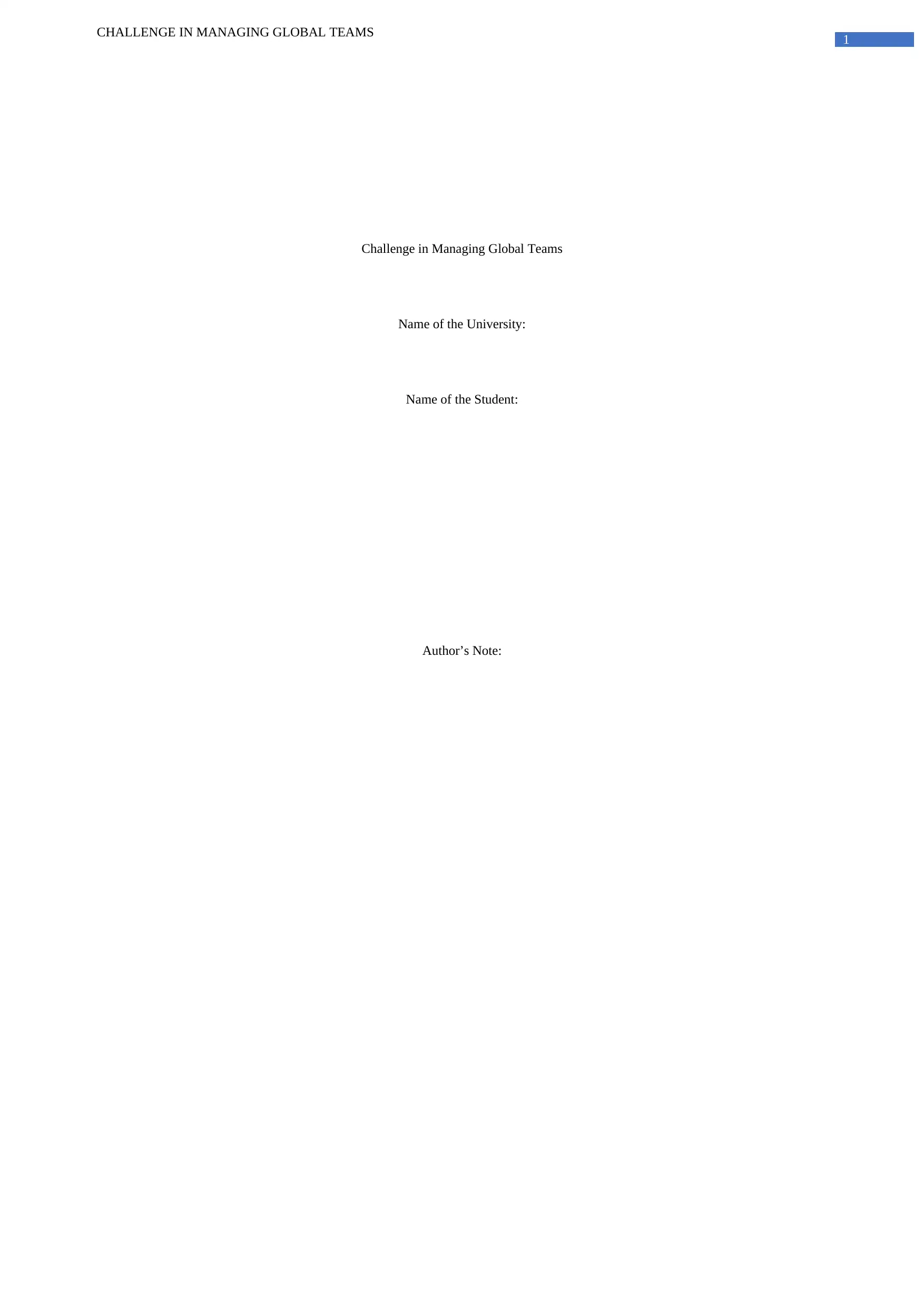
1
CHALLENGE IN MANAGING GLOBAL TEAMS
Challenge in Managing Global Teams
Name of the University:
Name of the Student:
Author’s Note:
CHALLENGE IN MANAGING GLOBAL TEAMS
Challenge in Managing Global Teams
Name of the University:
Name of the Student:
Author’s Note:
Paraphrase This Document
Need a fresh take? Get an instant paraphrase of this document with our AI Paraphraser
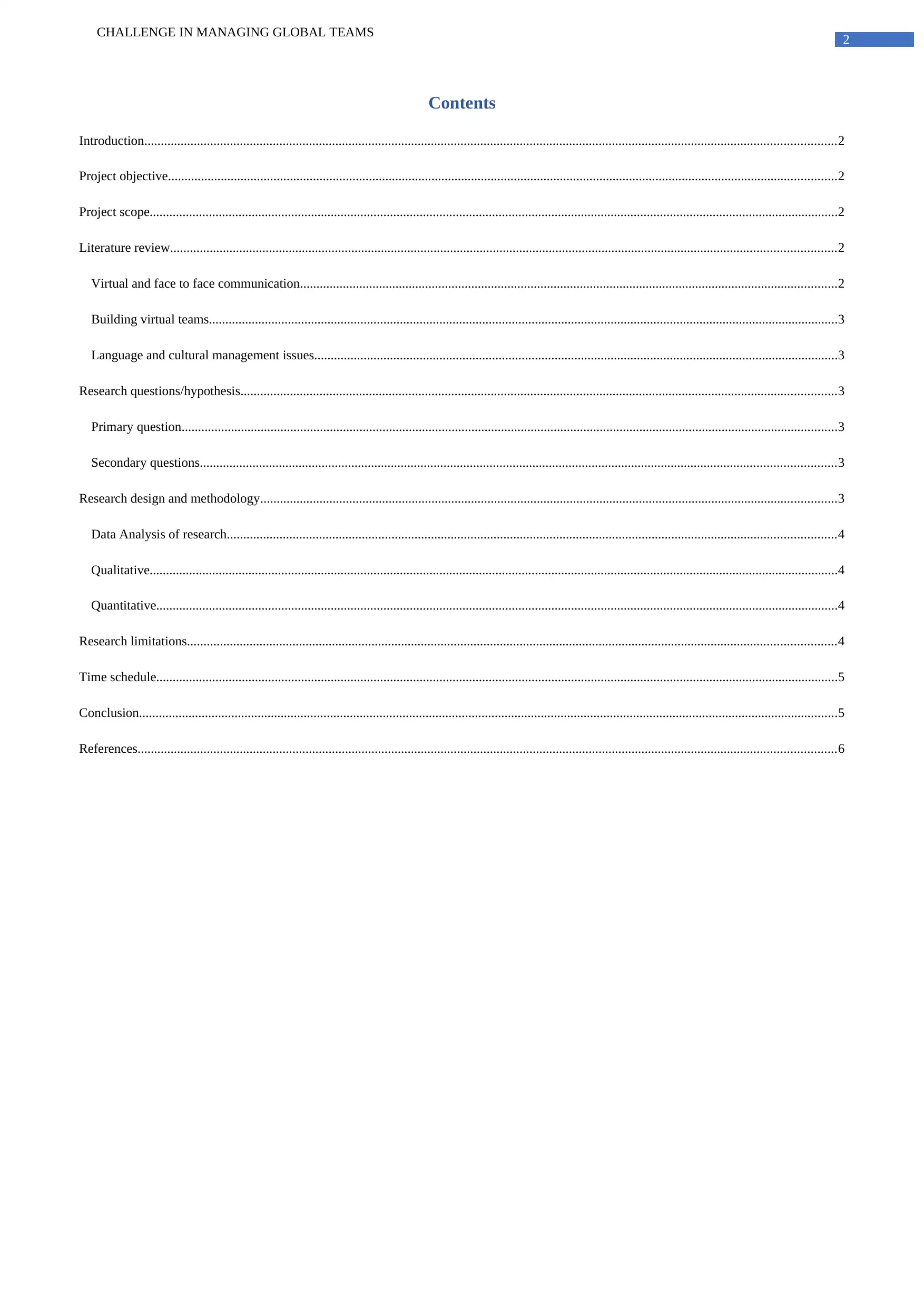
2
CHALLENGE IN MANAGING GLOBAL TEAMS
Contents
Introduction..................................................................................................................................................................................................................2
Project objective...........................................................................................................................................................................................................2
Project scope.................................................................................................................................................................................................................2
Literature review..........................................................................................................................................................................................................2
Virtual and face to face communication...................................................................................................................................................................2
Building virtual teams...............................................................................................................................................................................................3
Language and cultural management issues...............................................................................................................................................................3
Research questions/hypothesis.....................................................................................................................................................................................3
Primary question.......................................................................................................................................................................................................3
Secondary questions.................................................................................................................................................................................................3
Research design and methodology...............................................................................................................................................................................3
Data Analysis of research.........................................................................................................................................................................................4
Qualitative.................................................................................................................................................................................................................4
Quantitative...............................................................................................................................................................................................................4
Research limitations.....................................................................................................................................................................................................4
Time schedule...............................................................................................................................................................................................................5
Conclusion....................................................................................................................................................................................................................5
References....................................................................................................................................................................................................................6
CHALLENGE IN MANAGING GLOBAL TEAMS
Contents
Introduction..................................................................................................................................................................................................................2
Project objective...........................................................................................................................................................................................................2
Project scope.................................................................................................................................................................................................................2
Literature review..........................................................................................................................................................................................................2
Virtual and face to face communication...................................................................................................................................................................2
Building virtual teams...............................................................................................................................................................................................3
Language and cultural management issues...............................................................................................................................................................3
Research questions/hypothesis.....................................................................................................................................................................................3
Primary question.......................................................................................................................................................................................................3
Secondary questions.................................................................................................................................................................................................3
Research design and methodology...............................................................................................................................................................................3
Data Analysis of research.........................................................................................................................................................................................4
Qualitative.................................................................................................................................................................................................................4
Quantitative...............................................................................................................................................................................................................4
Research limitations.....................................................................................................................................................................................................4
Time schedule...............................................................................................................................................................................................................5
Conclusion....................................................................................................................................................................................................................5
References....................................................................................................................................................................................................................6
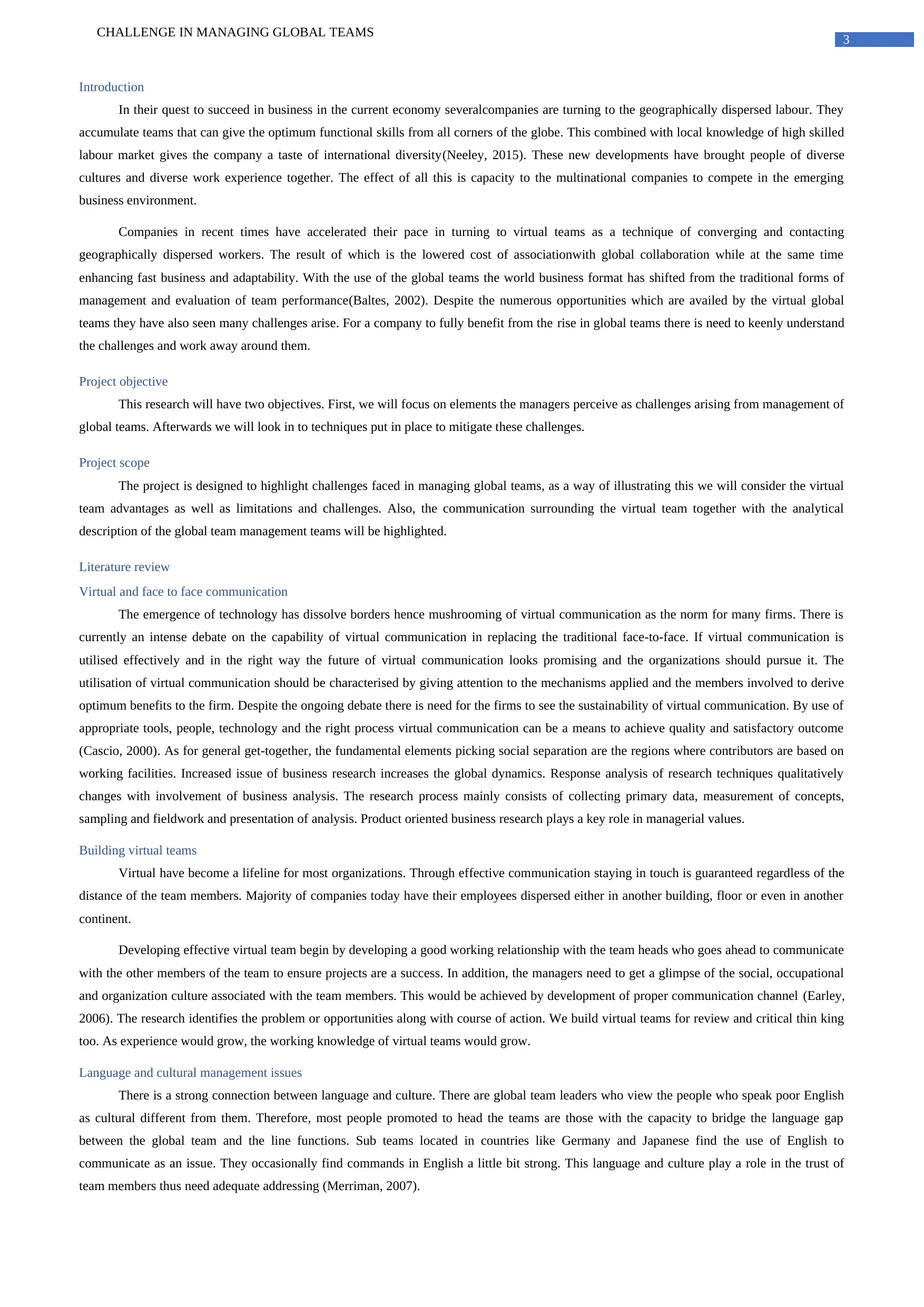
3
CHALLENGE IN MANAGING GLOBAL TEAMS
Introduction
In their quest to succeed in business in the current economy severalcompanies are turning to the geographically dispersed labour. They
accumulate teams that can give the optimum functional skills from all corners of the globe. This combined with local knowledge of high skilled
labour market gives the company a taste of international diversity(Neeley, 2015). These new developments have brought people of diverse
cultures and diverse work experience together. The effect of all this is capacity to the multinational companies to compete in the emerging
business environment.
Companies in recent times have accelerated their pace in turning to virtual teams as a technique of converging and contacting
geographically dispersed workers. The result of which is the lowered cost of associationwith global collaboration while at the same time
enhancing fast business and adaptability. With the use of the global teams the world business format has shifted from the traditional forms of
management and evaluation of team performance(Baltes, 2002). Despite the numerous opportunities which are availed by the virtual global
teams they have also seen many challenges arise. For a company to fully benefit from the rise in global teams there is need to keenly understand
the challenges and work away around them.
Project objective
This research will have two objectives. First, we will focus on elements the managers perceive as challenges arising from management of
global teams. Afterwards we will look in to techniques put in place to mitigate these challenges.
Project scope
The project is designed to highlight challenges faced in managing global teams, as a way of illustrating this we will consider the virtual
team advantages as well as limitations and challenges. Also, the communication surrounding the virtual team together with the analytical
description of the global team management teams will be highlighted.
Literature review
Virtual and face to face communication
The emergence of technology has dissolve borders hence mushrooming of virtual communication as the norm for many firms. There is
currently an intense debate on the capability of virtual communication in replacing the traditional face-to-face. If virtual communication is
utilised effectively and in the right way the future of virtual communication looks promising and the organizations should pursue it. The
utilisation of virtual communication should be characterised by giving attention to the mechanisms applied and the members involved to derive
optimum benefits to the firm. Despite the ongoing debate there is need for the firms to see the sustainability of virtual communication. By use of
appropriate tools, people, technology and the right process virtual communication can be a means to achieve quality and satisfactory outcome
(Cascio, 2000). As for general get-together, the fundamental elements picking social separation are the regions where contributors are based on
working facilities. Increased issue of business research increases the global dynamics. Response analysis of research techniques qualitatively
changes with involvement of business analysis. The research process mainly consists of collecting primary data, measurement of concepts,
sampling and fieldwork and presentation of analysis. Product oriented business research plays a key role in managerial values.
Building virtual teams
Virtual have become a lifeline for most organizations. Through effective communication staying in touch is guaranteed regardless of the
distance of the team members. Majority of companies today have their employees dispersed either in another building, floor or even in another
continent.
Developing effective virtual team begin by developing a good working relationship with the team heads who goes ahead to communicate
with the other members of the team to ensure projects are a success. In addition, the managers need to get a glimpse of the social, occupational
and organization culture associated with the team members. This would be achieved by development of proper communication channel (Earley,
2006). The research identifies the problem or opportunities along with course of action. We build virtual teams for review and critical thin king
too. As experience would grow, the working knowledge of virtual teams would grow.
Language and cultural management issues
There is a strong connection between language and culture. There are global team leaders who view the people who speak poor English
as cultural different from them. Therefore, most people promoted to head the teams are those with the capacity to bridge the language gap
between the global team and the line functions. Sub teams located in countries like Germany and Japanese find the use of English to
communicate as an issue. They occasionally find commands in English a little bit strong. This language and culture play a role in the trust of
team members thus need adequate addressing (Merriman, 2007).
CHALLENGE IN MANAGING GLOBAL TEAMS
Introduction
In their quest to succeed in business in the current economy severalcompanies are turning to the geographically dispersed labour. They
accumulate teams that can give the optimum functional skills from all corners of the globe. This combined with local knowledge of high skilled
labour market gives the company a taste of international diversity(Neeley, 2015). These new developments have brought people of diverse
cultures and diverse work experience together. The effect of all this is capacity to the multinational companies to compete in the emerging
business environment.
Companies in recent times have accelerated their pace in turning to virtual teams as a technique of converging and contacting
geographically dispersed workers. The result of which is the lowered cost of associationwith global collaboration while at the same time
enhancing fast business and adaptability. With the use of the global teams the world business format has shifted from the traditional forms of
management and evaluation of team performance(Baltes, 2002). Despite the numerous opportunities which are availed by the virtual global
teams they have also seen many challenges arise. For a company to fully benefit from the rise in global teams there is need to keenly understand
the challenges and work away around them.
Project objective
This research will have two objectives. First, we will focus on elements the managers perceive as challenges arising from management of
global teams. Afterwards we will look in to techniques put in place to mitigate these challenges.
Project scope
The project is designed to highlight challenges faced in managing global teams, as a way of illustrating this we will consider the virtual
team advantages as well as limitations and challenges. Also, the communication surrounding the virtual team together with the analytical
description of the global team management teams will be highlighted.
Literature review
Virtual and face to face communication
The emergence of technology has dissolve borders hence mushrooming of virtual communication as the norm for many firms. There is
currently an intense debate on the capability of virtual communication in replacing the traditional face-to-face. If virtual communication is
utilised effectively and in the right way the future of virtual communication looks promising and the organizations should pursue it. The
utilisation of virtual communication should be characterised by giving attention to the mechanisms applied and the members involved to derive
optimum benefits to the firm. Despite the ongoing debate there is need for the firms to see the sustainability of virtual communication. By use of
appropriate tools, people, technology and the right process virtual communication can be a means to achieve quality and satisfactory outcome
(Cascio, 2000). As for general get-together, the fundamental elements picking social separation are the regions where contributors are based on
working facilities. Increased issue of business research increases the global dynamics. Response analysis of research techniques qualitatively
changes with involvement of business analysis. The research process mainly consists of collecting primary data, measurement of concepts,
sampling and fieldwork and presentation of analysis. Product oriented business research plays a key role in managerial values.
Building virtual teams
Virtual have become a lifeline for most organizations. Through effective communication staying in touch is guaranteed regardless of the
distance of the team members. Majority of companies today have their employees dispersed either in another building, floor or even in another
continent.
Developing effective virtual team begin by developing a good working relationship with the team heads who goes ahead to communicate
with the other members of the team to ensure projects are a success. In addition, the managers need to get a glimpse of the social, occupational
and organization culture associated with the team members. This would be achieved by development of proper communication channel (Earley,
2006). The research identifies the problem or opportunities along with course of action. We build virtual teams for review and critical thin king
too. As experience would grow, the working knowledge of virtual teams would grow.
Language and cultural management issues
There is a strong connection between language and culture. There are global team leaders who view the people who speak poor English
as cultural different from them. Therefore, most people promoted to head the teams are those with the capacity to bridge the language gap
between the global team and the line functions. Sub teams located in countries like Germany and Japanese find the use of English to
communicate as an issue. They occasionally find commands in English a little bit strong. This language and culture play a role in the trust of
team members thus need adequate addressing (Merriman, 2007).
⊘ This is a preview!⊘
Do you want full access?
Subscribe today to unlock all pages.

Trusted by 1+ million students worldwide
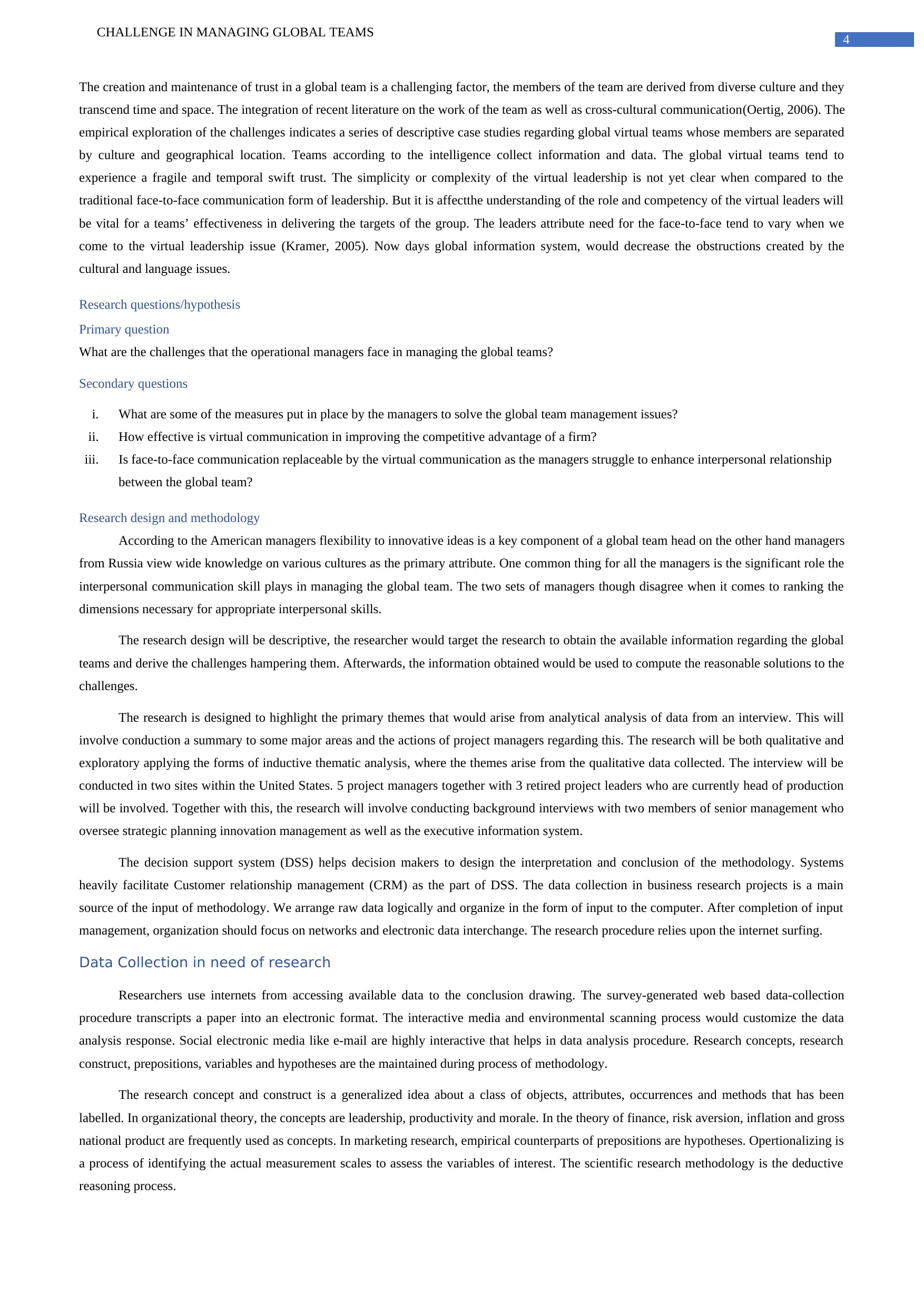
4
CHALLENGE IN MANAGING GLOBAL TEAMS
The creation and maintenance of trust in a global team is a challenging factor, the members of the team are derived from diverse culture and they
transcend time and space. The integration of recent literature on the work of the team as well as cross-cultural communication(Oertig, 2006). The
empirical exploration of the challenges indicates a series of descriptive case studies regarding global virtual teams whose members are separated
by culture and geographical location. Teams according to the intelligence collect information and data. The global virtual teams tend to
experience a fragile and temporal swift trust. The simplicity or complexity of the virtual leadership is not yet clear when compared to the
traditional face-to-face communication form of leadership. But it is affectthe understanding of the role and competency of the virtual leaders will
be vital for a teams’ effectiveness in delivering the targets of the group. The leaders attribute need for the face-to-face tend to vary when we
come to the virtual leadership issue (Kramer, 2005). Now days global information system, would decrease the obstructions created by the
cultural and language issues.
Research questions/hypothesis
Primary question
What are the challenges that the operational managers face in managing the global teams?
Secondary questions
i. What are some of the measures put in place by the managers to solve the global team management issues?
ii. How effective is virtual communication in improving the competitive advantage of a firm?
iii. Is face-to-face communication replaceable by the virtual communication as the managers struggle to enhance interpersonal relationship
between the global team?
Research design and methodology
According to the American managers flexibility to innovative ideas is a key component of a global team head on the other hand managers
from Russia view wide knowledge on various cultures as the primary attribute. One common thing for all the managers is the significant role the
interpersonal communication skill plays in managing the global team. The two sets of managers though disagree when it comes to ranking the
dimensions necessary for appropriate interpersonal skills.
The research design will be descriptive, the researcher would target the research to obtain the available information regarding the global
teams and derive the challenges hampering them. Afterwards, the information obtained would be used to compute the reasonable solutions to the
challenges.
The research is designed to highlight the primary themes that would arise from analytical analysis of data from an interview. This will
involve conduction a summary to some major areas and the actions of project managers regarding this. The research will be both qualitative and
exploratory applying the forms of inductive thematic analysis, where the themes arise from the qualitative data collected. The interview will be
conducted in two sites within the United States. 5 project managers together with 3 retired project leaders who are currently head of production
will be involved. Together with this, the research will involve conducting background interviews with two members of senior management who
oversee strategic planning innovation management as well as the executive information system.
The decision support system (DSS) helps decision makers to design the interpretation and conclusion of the methodology. Systems
heavily facilitate Customer relationship management (CRM) as the part of DSS. The data collection in business research projects is a main
source of the input of methodology. We arrange raw data logically and organize in the form of input to the computer. After completion of input
management, organization should focus on networks and electronic data interchange. The research procedure relies upon the internet surfing.
Data Collection in need of research
Researchers use internets from accessing available data to the conclusion drawing. The survey-generated web based data-collection
procedure transcripts a paper into an electronic format. The interactive media and environmental scanning process would customize the data
analysis response. Social electronic media like e-mail are highly interactive that helps in data analysis procedure. Research concepts, research
construct, prepositions, variables and hypotheses are the maintained during process of methodology.
The research concept and construct is a generalized idea about a class of objects, attributes, occurrences and methods that has been
labelled. In organizational theory, the concepts are leadership, productivity and morale. In the theory of finance, risk aversion, inflation and gross
national product are frequently used as concepts. In marketing research, empirical counterparts of prepositions are hypotheses. Opertionalizing is
a process of identifying the actual measurement scales to assess the variables of interest. The scientific research methodology is the deductive
reasoning process.
CHALLENGE IN MANAGING GLOBAL TEAMS
The creation and maintenance of trust in a global team is a challenging factor, the members of the team are derived from diverse culture and they
transcend time and space. The integration of recent literature on the work of the team as well as cross-cultural communication(Oertig, 2006). The
empirical exploration of the challenges indicates a series of descriptive case studies regarding global virtual teams whose members are separated
by culture and geographical location. Teams according to the intelligence collect information and data. The global virtual teams tend to
experience a fragile and temporal swift trust. The simplicity or complexity of the virtual leadership is not yet clear when compared to the
traditional face-to-face communication form of leadership. But it is affectthe understanding of the role and competency of the virtual leaders will
be vital for a teams’ effectiveness in delivering the targets of the group. The leaders attribute need for the face-to-face tend to vary when we
come to the virtual leadership issue (Kramer, 2005). Now days global information system, would decrease the obstructions created by the
cultural and language issues.
Research questions/hypothesis
Primary question
What are the challenges that the operational managers face in managing the global teams?
Secondary questions
i. What are some of the measures put in place by the managers to solve the global team management issues?
ii. How effective is virtual communication in improving the competitive advantage of a firm?
iii. Is face-to-face communication replaceable by the virtual communication as the managers struggle to enhance interpersonal relationship
between the global team?
Research design and methodology
According to the American managers flexibility to innovative ideas is a key component of a global team head on the other hand managers
from Russia view wide knowledge on various cultures as the primary attribute. One common thing for all the managers is the significant role the
interpersonal communication skill plays in managing the global team. The two sets of managers though disagree when it comes to ranking the
dimensions necessary for appropriate interpersonal skills.
The research design will be descriptive, the researcher would target the research to obtain the available information regarding the global
teams and derive the challenges hampering them. Afterwards, the information obtained would be used to compute the reasonable solutions to the
challenges.
The research is designed to highlight the primary themes that would arise from analytical analysis of data from an interview. This will
involve conduction a summary to some major areas and the actions of project managers regarding this. The research will be both qualitative and
exploratory applying the forms of inductive thematic analysis, where the themes arise from the qualitative data collected. The interview will be
conducted in two sites within the United States. 5 project managers together with 3 retired project leaders who are currently head of production
will be involved. Together with this, the research will involve conducting background interviews with two members of senior management who
oversee strategic planning innovation management as well as the executive information system.
The decision support system (DSS) helps decision makers to design the interpretation and conclusion of the methodology. Systems
heavily facilitate Customer relationship management (CRM) as the part of DSS. The data collection in business research projects is a main
source of the input of methodology. We arrange raw data logically and organize in the form of input to the computer. After completion of input
management, organization should focus on networks and electronic data interchange. The research procedure relies upon the internet surfing.
Data Collection in need of research
Researchers use internets from accessing available data to the conclusion drawing. The survey-generated web based data-collection
procedure transcripts a paper into an electronic format. The interactive media and environmental scanning process would customize the data
analysis response. Social electronic media like e-mail are highly interactive that helps in data analysis procedure. Research concepts, research
construct, prepositions, variables and hypotheses are the maintained during process of methodology.
The research concept and construct is a generalized idea about a class of objects, attributes, occurrences and methods that has been
labelled. In organizational theory, the concepts are leadership, productivity and morale. In the theory of finance, risk aversion, inflation and gross
national product are frequently used as concepts. In marketing research, empirical counterparts of prepositions are hypotheses. Opertionalizing is
a process of identifying the actual measurement scales to assess the variables of interest. The scientific research methodology is the deductive
reasoning process.
Paraphrase This Document
Need a fresh take? Get an instant paraphrase of this document with our AI Paraphraser
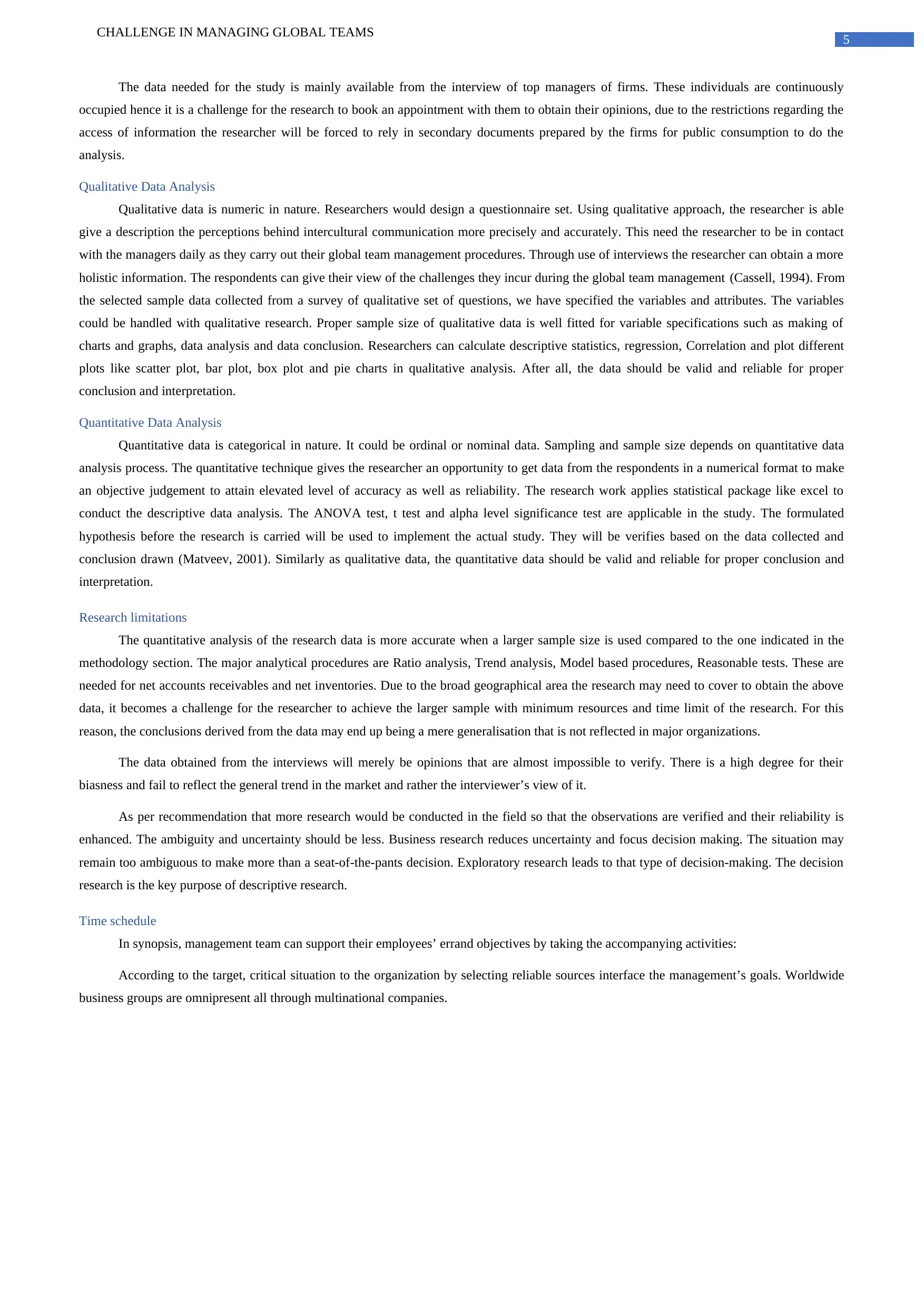
5
CHALLENGE IN MANAGING GLOBAL TEAMS
The data needed for the study is mainly available from the interview of top managers of firms. These individuals are continuously
occupied hence it is a challenge for the research to book an appointment with them to obtain their opinions, due to the restrictions regarding the
access of information the researcher will be forced to rely in secondary documents prepared by the firms for public consumption to do the
analysis.
Qualitative Data Analysis
Qualitative data is numeric in nature. Researchers would design a questionnaire set. Using qualitative approach, the researcher is able
give a description the perceptions behind intercultural communication more precisely and accurately. This need the researcher to be in contact
with the managers daily as they carry out their global team management procedures. Through use of interviews the researcher can obtain a more
holistic information. The respondents can give their view of the challenges they incur during the global team management (Cassell, 1994). From
the selected sample data collected from a survey of qualitative set of questions, we have specified the variables and attributes. The variables
could be handled with qualitative research. Proper sample size of qualitative data is well fitted for variable specifications such as making of
charts and graphs, data analysis and data conclusion. Researchers can calculate descriptive statistics, regression, Correlation and plot different
plots like scatter plot, bar plot, box plot and pie charts in qualitative analysis. After all, the data should be valid and reliable for proper
conclusion and interpretation.
Quantitative Data Analysis
Quantitative data is categorical in nature. It could be ordinal or nominal data. Sampling and sample size depends on quantitative data
analysis process. The quantitative technique gives the researcher an opportunity to get data from the respondents in a numerical format to make
an objective judgement to attain elevated level of accuracy as well as reliability. The research work applies statistical package like excel to
conduct the descriptive data analysis. The ANOVA test, t test and alpha level significance test are applicable in the study. The formulated
hypothesis before the research is carried will be used to implement the actual study. They will be verifies based on the data collected and
conclusion drawn (Matveev, 2001). Similarly as qualitative data, the quantitative data should be valid and reliable for proper conclusion and
interpretation.
Research limitations
The quantitative analysis of the research data is more accurate when a larger sample size is used compared to the one indicated in the
methodology section. The major analytical procedures are Ratio analysis, Trend analysis, Model based procedures, Reasonable tests. These are
needed for net accounts receivables and net inventories. Due to the broad geographical area the research may need to cover to obtain the above
data, it becomes a challenge for the researcher to achieve the larger sample with minimum resources and time limit of the research. For this
reason, the conclusions derived from the data may end up being a mere generalisation that is not reflected in major organizations.
The data obtained from the interviews will merely be opinions that are almost impossible to verify. There is a high degree for their
biasness and fail to reflect the general trend in the market and rather the interviewer’s view of it.
As per recommendation that more research would be conducted in the field so that the observations are verified and their reliability is
enhanced. The ambiguity and uncertainty should be less. Business research reduces uncertainty and focus decision making. The situation may
remain too ambiguous to make more than a seat-of-the-pants decision. Exploratory research leads to that type of decision-making. The decision
research is the key purpose of descriptive research.
Time schedule
In synopsis, management team can support their employees’ errand objectives by taking the accompanying activities:
According to the target, critical situation to the organization by selecting reliable sources interface the management’s goals. Worldwide
business groups are omnipresent all through multinational companies.
CHALLENGE IN MANAGING GLOBAL TEAMS
The data needed for the study is mainly available from the interview of top managers of firms. These individuals are continuously
occupied hence it is a challenge for the research to book an appointment with them to obtain their opinions, due to the restrictions regarding the
access of information the researcher will be forced to rely in secondary documents prepared by the firms for public consumption to do the
analysis.
Qualitative Data Analysis
Qualitative data is numeric in nature. Researchers would design a questionnaire set. Using qualitative approach, the researcher is able
give a description the perceptions behind intercultural communication more precisely and accurately. This need the researcher to be in contact
with the managers daily as they carry out their global team management procedures. Through use of interviews the researcher can obtain a more
holistic information. The respondents can give their view of the challenges they incur during the global team management (Cassell, 1994). From
the selected sample data collected from a survey of qualitative set of questions, we have specified the variables and attributes. The variables
could be handled with qualitative research. Proper sample size of qualitative data is well fitted for variable specifications such as making of
charts and graphs, data analysis and data conclusion. Researchers can calculate descriptive statistics, regression, Correlation and plot different
plots like scatter plot, bar plot, box plot and pie charts in qualitative analysis. After all, the data should be valid and reliable for proper
conclusion and interpretation.
Quantitative Data Analysis
Quantitative data is categorical in nature. It could be ordinal or nominal data. Sampling and sample size depends on quantitative data
analysis process. The quantitative technique gives the researcher an opportunity to get data from the respondents in a numerical format to make
an objective judgement to attain elevated level of accuracy as well as reliability. The research work applies statistical package like excel to
conduct the descriptive data analysis. The ANOVA test, t test and alpha level significance test are applicable in the study. The formulated
hypothesis before the research is carried will be used to implement the actual study. They will be verifies based on the data collected and
conclusion drawn (Matveev, 2001). Similarly as qualitative data, the quantitative data should be valid and reliable for proper conclusion and
interpretation.
Research limitations
The quantitative analysis of the research data is more accurate when a larger sample size is used compared to the one indicated in the
methodology section. The major analytical procedures are Ratio analysis, Trend analysis, Model based procedures, Reasonable tests. These are
needed for net accounts receivables and net inventories. Due to the broad geographical area the research may need to cover to obtain the above
data, it becomes a challenge for the researcher to achieve the larger sample with minimum resources and time limit of the research. For this
reason, the conclusions derived from the data may end up being a mere generalisation that is not reflected in major organizations.
The data obtained from the interviews will merely be opinions that are almost impossible to verify. There is a high degree for their
biasness and fail to reflect the general trend in the market and rather the interviewer’s view of it.
As per recommendation that more research would be conducted in the field so that the observations are verified and their reliability is
enhanced. The ambiguity and uncertainty should be less. Business research reduces uncertainty and focus decision making. The situation may
remain too ambiguous to make more than a seat-of-the-pants decision. Exploratory research leads to that type of decision-making. The decision
research is the key purpose of descriptive research.
Time schedule
In synopsis, management team can support their employees’ errand objectives by taking the accompanying activities:
According to the target, critical situation to the organization by selecting reliable sources interface the management’s goals. Worldwide
business groups are omnipresent all through multinational companies.
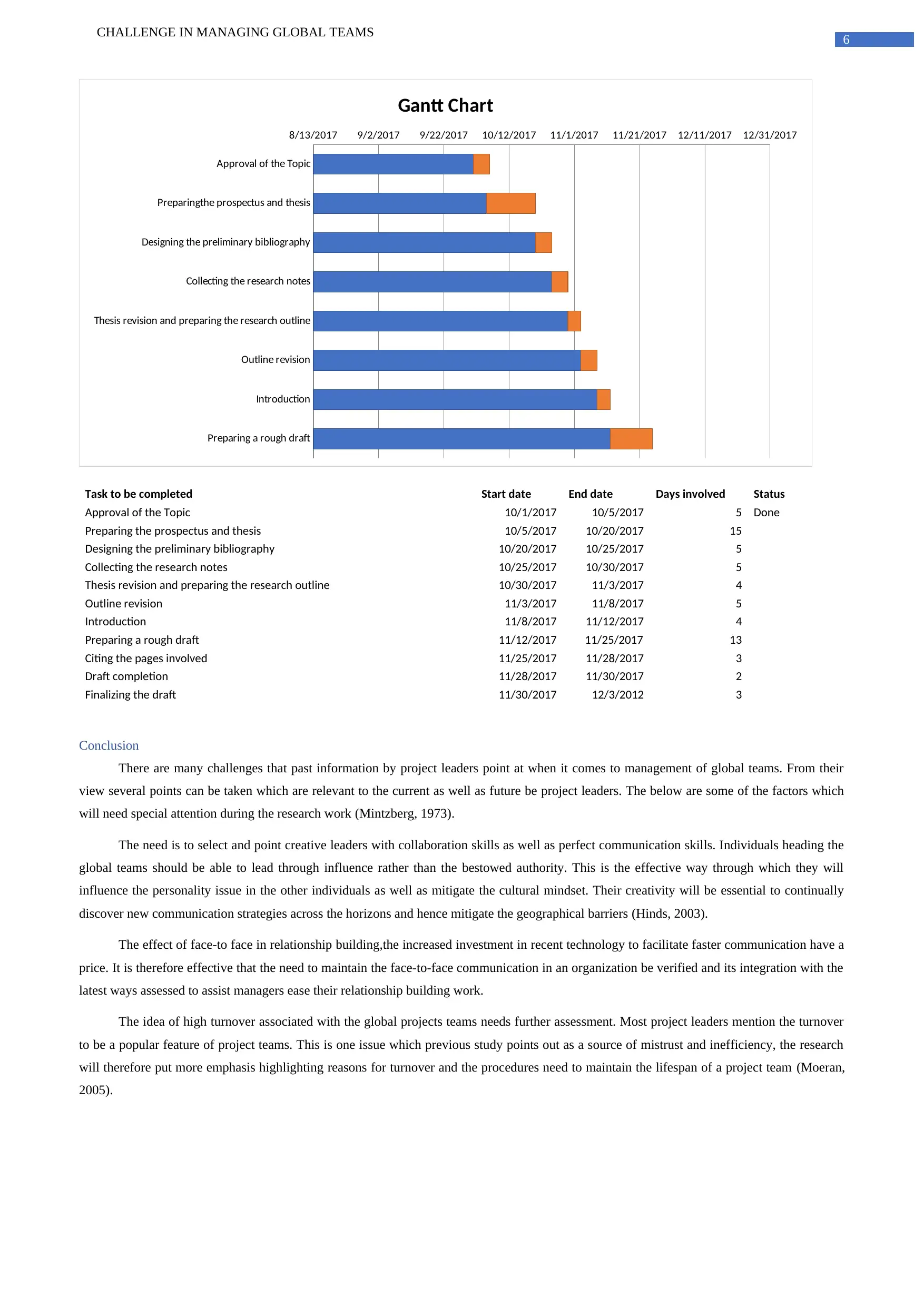
6
CHALLENGE IN MANAGING GLOBAL TEAMS
Approval of the Topic
Preparingthe prospectus and thesis
Designing the preliminary bibliography
Collecting the research notes
Thesis revision and preparing the research outline
Outline revision
Introduction
Preparing a rough draft
8/13/2017 9/2/2017 9/22/2017 10/12/2017 11/1/2017 11/21/2017 12/11/2017 12/31/2017
Gantt Chart
Task to be completed Start date End date Days involved Status
Approval of the Topic 10/1/2017 10/5/2017 5 Done
Preparing the prospectus and thesis 10/5/2017 10/20/2017 15
Designing the preliminary bibliography 10/20/2017 10/25/2017 5
Collecting the research notes 10/25/2017 10/30/2017 5
Thesis revision and preparing the research outline 10/30/2017 11/3/2017 4
Outline revision 11/3/2017 11/8/2017 5
Introduction 11/8/2017 11/12/2017 4
Preparing a rough draft 11/12/2017 11/25/2017 13
Citing the pages involved 11/25/2017 11/28/2017 3
Draft completion 11/28/2017 11/30/2017 2
Finalizing the draft 11/30/2017 12/3/2012 3
Conclusion
There are many challenges that past information by project leaders point at when it comes to management of global teams. From their
view several points can be taken which are relevant to the current as well as future be project leaders. The below are some of the factors which
will need special attention during the research work (Mintzberg, 1973).
The need is to select and point creative leaders with collaboration skills as well as perfect communication skills. Individuals heading the
global teams should be able to lead through influence rather than the bestowed authority. This is the effective way through which they will
influence the personality issue in the other individuals as well as mitigate the cultural mindset. Their creativity will be essential to continually
discover new communication strategies across the horizons and hence mitigate the geographical barriers (Hinds, 2003).
The effect of face-to face in relationship building,the increased investment in recent technology to facilitate faster communication have a
price. It is therefore effective that the need to maintain the face-to-face communication in an organization be verified and its integration with the
latest ways assessed to assist managers ease their relationship building work.
The idea of high turnover associated with the global projects teams needs further assessment. Most project leaders mention the turnover
to be a popular feature of project teams. This is one issue which previous study points out as a source of mistrust and inefficiency, the research
will therefore put more emphasis highlighting reasons for turnover and the procedures need to maintain the lifespan of a project team (Moeran,
2005).
CHALLENGE IN MANAGING GLOBAL TEAMS
Approval of the Topic
Preparingthe prospectus and thesis
Designing the preliminary bibliography
Collecting the research notes
Thesis revision and preparing the research outline
Outline revision
Introduction
Preparing a rough draft
8/13/2017 9/2/2017 9/22/2017 10/12/2017 11/1/2017 11/21/2017 12/11/2017 12/31/2017
Gantt Chart
Task to be completed Start date End date Days involved Status
Approval of the Topic 10/1/2017 10/5/2017 5 Done
Preparing the prospectus and thesis 10/5/2017 10/20/2017 15
Designing the preliminary bibliography 10/20/2017 10/25/2017 5
Collecting the research notes 10/25/2017 10/30/2017 5
Thesis revision and preparing the research outline 10/30/2017 11/3/2017 4
Outline revision 11/3/2017 11/8/2017 5
Introduction 11/8/2017 11/12/2017 4
Preparing a rough draft 11/12/2017 11/25/2017 13
Citing the pages involved 11/25/2017 11/28/2017 3
Draft completion 11/28/2017 11/30/2017 2
Finalizing the draft 11/30/2017 12/3/2012 3
Conclusion
There are many challenges that past information by project leaders point at when it comes to management of global teams. From their
view several points can be taken which are relevant to the current as well as future be project leaders. The below are some of the factors which
will need special attention during the research work (Mintzberg, 1973).
The need is to select and point creative leaders with collaboration skills as well as perfect communication skills. Individuals heading the
global teams should be able to lead through influence rather than the bestowed authority. This is the effective way through which they will
influence the personality issue in the other individuals as well as mitigate the cultural mindset. Their creativity will be essential to continually
discover new communication strategies across the horizons and hence mitigate the geographical barriers (Hinds, 2003).
The effect of face-to face in relationship building,the increased investment in recent technology to facilitate faster communication have a
price. It is therefore effective that the need to maintain the face-to-face communication in an organization be verified and its integration with the
latest ways assessed to assist managers ease their relationship building work.
The idea of high turnover associated with the global projects teams needs further assessment. Most project leaders mention the turnover
to be a popular feature of project teams. This is one issue which previous study points out as a source of mistrust and inefficiency, the research
will therefore put more emphasis highlighting reasons for turnover and the procedures need to maintain the lifespan of a project team (Moeran,
2005).
⊘ This is a preview!⊘
Do you want full access?
Subscribe today to unlock all pages.

Trusted by 1+ million students worldwide
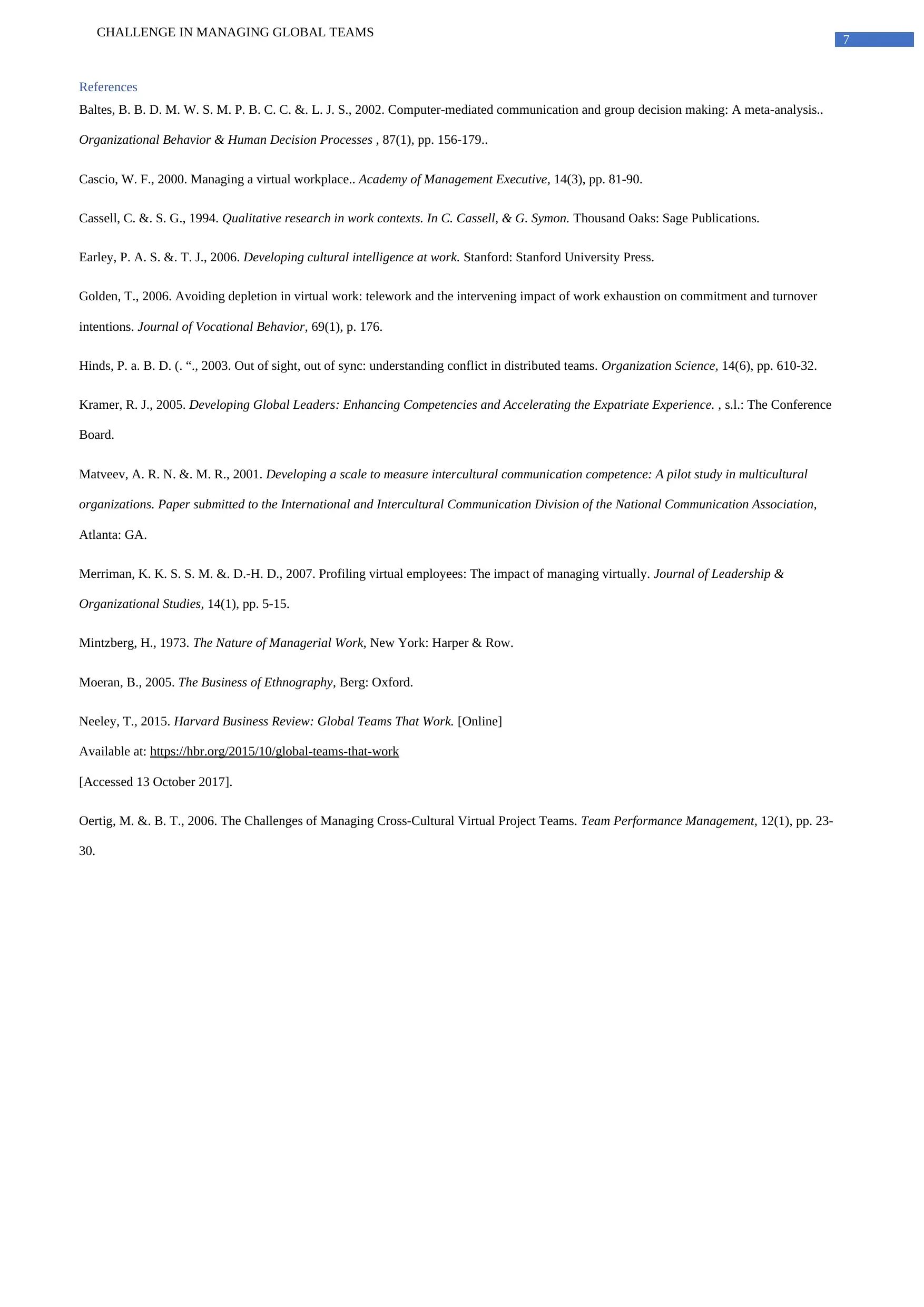
7
CHALLENGE IN MANAGING GLOBAL TEAMS
References
Baltes, B. B. D. M. W. S. M. P. B. C. C. &. L. J. S., 2002. Computer-mediated communication and group decision making: A meta-analysis..
Organizational Behavior & Human Decision Processes , 87(1), pp. 156-179..
Cascio, W. F., 2000. Managing a virtual workplace.. Academy of Management Executive, 14(3), pp. 81-90.
Cassell, C. &. S. G., 1994. Qualitative research in work contexts. In C. Cassell, & G. Symon. Thousand Oaks: Sage Publications.
Earley, P. A. S. &. T. J., 2006. Developing cultural intelligence at work. Stanford: Stanford University Press.
Golden, T., 2006. Avoiding depletion in virtual work: telework and the intervening impact of work exhaustion on commitment and turnover
intentions. Journal of Vocational Behavior, 69(1), p. 176.
Hinds, P. a. B. D. (. “., 2003. Out of sight, out of sync: understanding conflict in distributed teams. Organization Science, 14(6), pp. 610-32.
Kramer, R. J., 2005. Developing Global Leaders: Enhancing Competencies and Accelerating the Expatriate Experience. , s.l.: The Conference
Board.
Matveev, A. R. N. &. M. R., 2001. Developing a scale to measure intercultural communication competence: A pilot study in multicultural
organizations. Paper submitted to the International and Intercultural Communication Division of the National Communication Association,
Atlanta: GA.
Merriman, K. K. S. S. M. &. D.-H. D., 2007. Profiling virtual employees: The impact of managing virtually. Journal of Leadership &
Organizational Studies, 14(1), pp. 5-15.
Mintzberg, H., 1973. The Nature of Managerial Work, New York: Harper & Row.
Moeran, B., 2005. The Business of Ethnography, Berg: Oxford.
Neeley, T., 2015. Harvard Business Review: Global Teams That Work. [Online]
Available at: https://hbr.org/2015/10/global-teams-that-work
[Accessed 13 October 2017].
Oertig, M. &. B. T., 2006. The Challenges of Managing Cross-Cultural Virtual Project Teams. Team Performance Management, 12(1), pp. 23-
30.
CHALLENGE IN MANAGING GLOBAL TEAMS
References
Baltes, B. B. D. M. W. S. M. P. B. C. C. &. L. J. S., 2002. Computer-mediated communication and group decision making: A meta-analysis..
Organizational Behavior & Human Decision Processes , 87(1), pp. 156-179..
Cascio, W. F., 2000. Managing a virtual workplace.. Academy of Management Executive, 14(3), pp. 81-90.
Cassell, C. &. S. G., 1994. Qualitative research in work contexts. In C. Cassell, & G. Symon. Thousand Oaks: Sage Publications.
Earley, P. A. S. &. T. J., 2006. Developing cultural intelligence at work. Stanford: Stanford University Press.
Golden, T., 2006. Avoiding depletion in virtual work: telework and the intervening impact of work exhaustion on commitment and turnover
intentions. Journal of Vocational Behavior, 69(1), p. 176.
Hinds, P. a. B. D. (. “., 2003. Out of sight, out of sync: understanding conflict in distributed teams. Organization Science, 14(6), pp. 610-32.
Kramer, R. J., 2005. Developing Global Leaders: Enhancing Competencies and Accelerating the Expatriate Experience. , s.l.: The Conference
Board.
Matveev, A. R. N. &. M. R., 2001. Developing a scale to measure intercultural communication competence: A pilot study in multicultural
organizations. Paper submitted to the International and Intercultural Communication Division of the National Communication Association,
Atlanta: GA.
Merriman, K. K. S. S. M. &. D.-H. D., 2007. Profiling virtual employees: The impact of managing virtually. Journal of Leadership &
Organizational Studies, 14(1), pp. 5-15.
Mintzberg, H., 1973. The Nature of Managerial Work, New York: Harper & Row.
Moeran, B., 2005. The Business of Ethnography, Berg: Oxford.
Neeley, T., 2015. Harvard Business Review: Global Teams That Work. [Online]
Available at: https://hbr.org/2015/10/global-teams-that-work
[Accessed 13 October 2017].
Oertig, M. &. B. T., 2006. The Challenges of Managing Cross-Cultural Virtual Project Teams. Team Performance Management, 12(1), pp. 23-
30.
1 out of 7
Related Documents
Your All-in-One AI-Powered Toolkit for Academic Success.
+13062052269
info@desklib.com
Available 24*7 on WhatsApp / Email
![[object Object]](/_next/static/media/star-bottom.7253800d.svg)
Unlock your academic potential
Copyright © 2020–2025 A2Z Services. All Rights Reserved. Developed and managed by ZUCOL.





